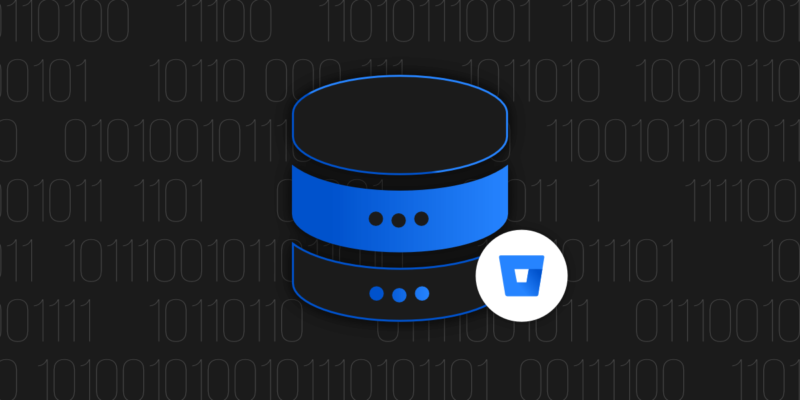
Bitbucket Server Backup Client – Overview and Alternatives
If you’re looking for a reliable, powerful backup solution for your Bitbucket server, the Bitbucket Server Backup Client may look attractive to you. With Bitbucket Server Backup Client, you can be sure that your data is backed up and protected in a secure location, so you can focus on running your business without any worries about losing important data. But is it really the right answer for your backup and security needs? And is this solution the best on the market?
Read the following article to find out how Bitbucket Server Backup Client works and learn about its alternative.
Why you need to backup your Bitbucket Server – Backup Client
The Bitbucket Server Backup Client is a powerful tool that helps you easily create backups of your Bitbucket Server data. In this blog post, we’ll explain why you need to use the Backup Client and how it can help you keep your code safe. The Bitbucket Server Backup Client is a free and open-source tool that allows you to easily create backups of your Bitbucket Server data. The client is available for Windows, Linux, and macOS.
The client is easy to use and can be configured to run automatically on a schedule. The client supports multiple backup strategies, including full and incremental backups. Full backups capture all of the data in your Bitbucket Server instance, while incremental backups only capture the data that has been changed since the latest backup.
The client also supports multiple storage destinations, including local storage, Amazon S3, Google Cloud Storage, and Azure Blob Storage. You can configure the client to send backups to multiple destinations for additional safety. The Bitbucket Server Backup Client is an important tool for keeping your code safe. If you haven’t started using it yet, we encourage you to download it and try it today.
Eliminate data loss risk and ensure business continuity with the first TRUE Disaster Recovery software for Bitbucket.
How Bitbucket Server Backup Client works
The Bitbucket Server Backup Client is a tool that makes it easy to create backups of your Bitbucket Server instance. It can be run either from the command line or from within the Bitbucket Server web interface. The client will create a compressed archive of your Bitbucket Server data, which can then be stored in a safe location. The client can be configured to run automatically on a schedule, or it can be run manually when needed.
The Backup Client locks access to Bitbucket Server, the repositories it manages, and the Bitbucket Server database while it backs up all the information. This process is called the ‘maintenance mode.’ To complete the backup, the client checks that all Git and database operations have been completed then creates a tar file of the home directory and database in a specified location. Finally, it unlocks Bitbucket Server from maintenance mode. You’ll receive an error message if you try to access Bitbucket Server while it’s in maintenance mode.
What data is secured
The Backup Client backs up all of the following data:
- the database that Bitbucket Server is connected to
- Bitbucket Server audit logs
- installed plugins and their data
- managed Git repositories
The backup does NOT include the following files and directories:
- export/*
- tmp
- log/* (except for audit logs)
- plugins directory
- shared/data/db*
Restoring Bitbucket Server
This section explains what to do if you need to restore the Bitbucket Server, but you can use the existing database that it was backed up from. This scenario assumes that Bitbucket Server will be restored to the same server from which it was originally backed up.
To make sure no existing data is accidentally deleted, the Restore Client will only restore the Bitbucket Server into an empty home directory and an empty database. The Restore Client will use the JDBC connection configuration contained in the backup you are restoring from.
Here’s the process:
- Stop your Bitbucket Server instance.
- Delete everything in the current home directory, leaving it empty.
- Drop the existing tables in your database so it is empty. The database still needs to have the same user/password, and it should have the configuration described in the backup file. If you need to restore the Bitbucket Server to its previous state, you can use the existing database (DB) that Bitbucket Server was backed up from. This process assumes that Bitbucket Server is being restored to the same server from which it was originally backed up.
- The first step is to stop your Bitbucket Server instance. Then, you’ll need to delete the contents of the current home directory so that it’s empty. Next, add the existing tables into your database so it’s also empty. Note that the database still needs to have that’s same credentials – user/password configuration.
- Now you’re ready to run the Restore Client on the machine that Bitbucket Server should be restored to. The Restore Client will use the JDBC connection configuration contained in the backup you are restoring from. Keep in mind that the Restore Client is designed only to restore an empty home directory and an empty database, to prevent the accidental deletion of any existing data.
Following these steps will help you successfully restore the Bitbucket Server to its previous state.
The advantages of GitProtect.io over other backup clients
When it comes to backup, there are a lot of options out there. But if you’re looking for a reliable and robust DevOps backup – and the one especially focused on Bitbucket and Atlassian ecosystem – GitProtect is the way to go. Here’s why: GitProtect offers comprehensive protection for your data like automatic backup, backup-on-demand, Disaster Recovery, granular recovery, backup replication, and ransomware&anti-wipe protection.
You can be sure that all of your data – repositories with related metadata – are easily protected according to your compliance needs.
GitProtect is easy to use and offers great UX that makes it easy to set up and manage your backups. If you ever need to restore your data, GitProtect will make it easy to do so with just a few clicks. Finally, GitProtect introduces a holistic approach to DevOps backup which makes it a great option for Heads of IT, Security Teams, C-Level Management, and more.






